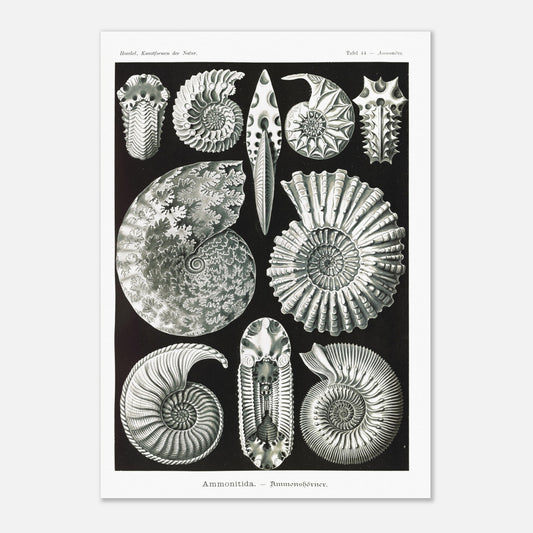Ammonites - Zoological and botanical plate - Ernst Haeckel, Kunstformen der Natur
Ammonites - Zoological and botanical plate - Ernst Haeckel, Kunstformen der Natur
Couldn't load pickup availability
Reproduction engraving of: Ammonites
Original title Ammonitida - Ammonshörner
Poster of Ammonites - Mollusks of the class Cephalopoda or Cephalopods (Family of ammonites, ammonitida)
Illustration from the book Kunstformen der Natur, which is a collection of artistic lithographs of natural sciences published by the German biologist Ernst Haeckel between 1899 and 1904.
This naturalistic illustration is part of an overall style inspired by Ernst Haeckel, which greatly influenced the emerging Art Nouveau movement at the beginning of the 20th century. This work, illustrating the impressive beauty and great diversity of the biological world, was complemented by a certain amount of scientific information, some excerpts of which are reproduced below.
This information is over 120 years old and some of it may be outdated!
Scientific classification:
Mollusca Phylum Class Cephalopoda Family of Ammonites (Ammonitida or Ammonoidea)
Scientific notice (extract) accompanying the poster print of Ammonitida - Ammonites :
The form-rich family of Ammonites forms a very interesting group of long-extinct cephalopods, the most highly organized mollusks. These mollusks lived in thousands of species during the Paleozoic and especially during the Mesozoic eras, but became completely extinct toward the end of the Cretaceous period. Their well-formed calcareous shells accumulated in a fossil state in such quantities that they predominantly compose large mountain masses, for example in the Jura, the various layers of which can be characterized by definite forms of ammonites. The mollusk that formed the many-chambered shells and inhabited the last (most recent) chamber of this is completely unknown to us as to its particular organization; it can only be stated with absolute certainty that it was a true cephalopod, just like Nautilus, Octopus, and Sepia. But the formation of the shell alone does not allow us to determine whether the ammonites were the closest relatives of Nautilus and belonged like it to the Tetrabranchials (Tetrabranchia), or rather to the Dibranchials (Dibranchia), like Spirula, Sepia and Octopus. The calcareous shell of the ammonites is planospiral, coiled symmetrically in a plane, and consists of a large number of chambers separated by solid partitions. The chambers were filled with air, as is the case in the tetrabranchial Nautilus and dibranchial Spirula still living today; they formed an excellent hydrostatic apparatus that reduced the specific weight of the body and facilitated swimming, similar to the swim bladder of fish. The living animal inhabited the newest and largest chamber, formed last, and was attached to it by a strong cord (siphon) that pierced the partitions. The septa of the air chambers (visible from the front in Figs. 2, 4, 6 and 8) are more or less undulated, so that their junction with the outer wall of the shell is not in a simple circular line, but in elegantly curved suture lines or lobed lines, the branched projections of which are distinguished into lobes and saddles (Fig. 5). In addition, the outer surface of the shell is often decorated with radiating ribs, crests, ridges, spines, etc.
Species present on the naturalist board of Ammonites - Ammonites :
- Ammonites cordatus
- Cardioceras cordatus
- Ammonites coupei
- Schloenbachia coupei
- Ammonites opulentus
- Ptychites opulentus
- Ammonites ornatus
- Ammonites mammilaris
- Ammonites planulatus
- Ammonites cavernosus
- Ammonites amaltheus
- Ammonites rotula
- Ammonites hymphryi
- Ammonites stephanoceras
About this print
About this print
The layout and composition of this reproduction have been the subject of our greatest attention.
- Respect for the format of the original work: in order to faithfully transcribe the artist's intention, the work is not cropped/re-cut except in extreme cases (obvious imperfection, geometry problem, etc.) in which case the cropping will be as light as possible.
- The presence of white margins is sometimes necessary in order to present the work in a balanced manner.
- Each size offered has been specifically composed, therefore, the size of the white margins may vary from one print size to another. Remember to check this detail carefully!
- Print only, frame not included!
Features
Features
- Premium 200gsm matte white paper, durable and strong.
- Natural, smooth uncoated finish, silky to the touch
- FSC certified paper or equivalent certifications depending on regional availability.
- Each print is shipped in sturdy packaging, ensuring safe transport.
- Each print is printed and shipped on demand. No minimum order quantity is required.
Share !









Recently viewed products
We are listening to you
If you are looking for a specific composition, a particular layout, or any other customization need, our team is at your disposal and will do everything possible to meet your requests.
So don't hesitate to...




